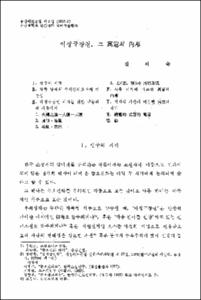산업구조조정과 제조업 노동시장의 구조변화(1987-1994년)
- Alternative Title
- Structural Change of the Labour Market in the Manufacturing Sector during the Period of Industrial Adjustment in Korea(1987-1994)
- Abstract
- 80년대 말 이후 한국의 제조업부문 노동시장은 급격한 구조변화를 겪고 있다. 본 연구의 목적은 제조업 부문 생산직 노동시장의 구조변화를 현재 진행 중인 한국경제의 산업구조조정의 성격과 연관시켜 규명하는 것이다. 본 연구의 성과를 정리하면 다음과 같다.
1) '성장산업의 경쟁력 강화'로 집약되는 현단계 산업구조조정의 성격은 생산직 노동시장의 수급구조를 성장산업과 사양산업에서 상이하게 변화시키고 있다. 노동시장의 수급구조가 이렇게 변화됨에 따라 성장산업의 취업자 ?測? 지속적으로 증가하고, 사양산업의 취업자 수는 감소하는 추세를 보인다.
2) 성장산업과 사양산업의 생산직 노동시장의 공급구조가 상이하게 변화되는 이유는 성장산업과 사양산업의 노동비용 격차 때문이다. 이에 따라 성장산업은 노동력 수요가 급속히 증가함에도 불구하고 인력난을 겪지 않는 반면, 사양산업은 노동력 수요가 감소함에도 불구하고 심한 인력난을 겪고 있다. 이처럼 대조적인 양상은 대기업에서 더욱 뚜렷하게 나타난다. 임금과 고용안정성을 기준으로 볼 때 내부노동시장이 형성된 것이다.
3) 내부노동시장이 형성됐음에도 불구하고 성장산업 대기업에 고유한 기업특수적 숙련은 아직 발달되지 않고 있다. 관리감독은 강화되지만 기능적 숙련의 수준은 높아지지 않고 있다. 이는 현단계 산업구조조정의 성격과 밀접히 연관된 것으로 이해할 수 있다. 성장산업의 대기업들은 생산직 노동자들의 숙련수준을 획기적으로 높임으로써 기존의 대량생산에서 벗어나려고 하기보다는 대량생산방식을 재정비하면서 단순반복적인 반(분)숙련노동을 고수하고 있다. 따라서 성장산업 대기업의 내부노동시장은 '개방형' 내부노동시장의 특성을 보인다.
The labour market in the manufacturing sector in Korea has experienced a structural change since the late 1980s. The purpose of this study is to explain the structural change in relation to the ongoing industrial adjustment in Korea since the late 1980s.
The results of this study are as follows.
1) The industrial adjustment under way is focused on the strengthening of high-growth industries such as automobiles, electronics, shipbuilding etc. The industrial adjustment affects the demand and supply structure of the blue collar labour market unevenly. That is, while the number of blue collar workers is rapidly increasing in the high-growth industries, it is considerably decreasing in the low-growth industries such as textiles, garments, footgear etc.
2) The reason why the supply of blue collar worker is rapidly growing in the high-growth in this is because of the increase of wages in this sector. As wages keep increasing in this sector, the turn-over rate of blue collar workers is rapidly decreasing. Especially this phenomenon is distinct in the big companies of the high-growth industries. As regards wages and employment stability are concerned, the internal labour market seems to have been formed within the big companies of the high-growth industries.
3) Even though the internal labour market in this sector has been formed, firm specific skills have not been developed yet. The functional skill remains as low level, while the function of management and monitoring is kept on intensifying. While the mass production system is being restructured, the simple and repetitive nature of work in the big companies of the high-growth industries largely persists. According to Doeringer and Piore, the characteristic of the labour market in this sector is the 'open' type of the internal labour market.
The labour market in the manufacturing sector in Korea has experienced a structural change since the late 1980s. The purpose of this study is to explain the structural change in relation to the ongoing industrial adjustment in Korea since the late 1980s.
The results of this study are as follows.
1) The industrial adjustment under way is focused on the strengthening of high-growth industries such as automobiles, electronics, shipbuilding etc. The industrial adjustment affects the demand and supply structure of the blue collar labour market unevenly. That is, while the number of blue collar workers is rapidly increasing in the high-growth industries, it is considerably decreasing in the low-growth industries such as textiles, garments, footgear etc.
2) The reason why the supply of blue collar worker is rapidly growing in the high-growth in this is because of the increase of wages in this sector. As wages keep increasing in this sector, the turn-over rate of blue collar workers is rapidly decreasing. Especially this phenomenon is distinct in the big companies of the high-growth industries. As regards wages and employment stability are concerned, the internal labour market seems to have been formed within the big companies of the high-growth industries.
3) Even though the internal labour market in this sector has been formed, firm specific skills have not been developed yet. The functional skill remains as low level, while the function of management and monitoring is kept on intensifying. While the mass production system is being restructured, the simple and repetitive nature of work in the big companies of the high-growth industries largely persists. According to Doeringer and Piore, the characteristic of the labour market in this sector is the 'open' type of the internal labour market.
- Issued Date
- 1995
- Type
- Research Laboratory
- Alternative Author(s)
- Cho, Hyung-Je
- Publisher
- 사회과학논집
- Language
- kor
- Rights
- 울산대학교 저작물은 저작권에 의해 보호받습니다.
- Citation Volume
- 5
- Citation Number
- 2
- Citation Start Page
- 261
- Citation End Page
- 275
- Appears in Collections:
- Research Laboratory > Journal of social science
- 파일 목록
-
-
Download
 000002024608.pdf
기타 데이터 / 1.74 MB / Adobe PDF
000002024608.pdf
기타 데이터 / 1.74 MB / Adobe PDF
-
Items in Repository are protected by copyright, with all rights reserved, unless otherwise indicated.